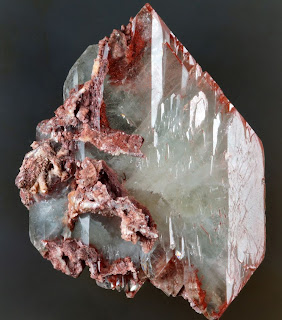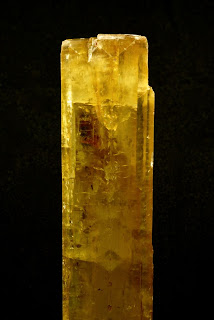Westgarth Forster 1821: "Cauk, or barytic, spar"
One of the treasured crystallized minerals from the mines of Northern England is the barium sulphate barite (or baryte).
Westgarth Forster (1821, pages 216-217), makes the following comments on this mineral:
Beautiful doubly-terminated 6 cm blue barite from Frizington, Cumbria, with red areas resulting from hematite inclusions.
Westgarth Forster (1821, pages 216-217), makes the following comments on this mineral:
“Cauk, or barytic, spar, is not generally of so
pure a white as the calcareous spars. The writer of this has seen cauk spar of a dead white, but commonly
it is of a yellowish, a brownish, or a reddish white, or of a flesh colour,
sometimes crystallized and transparent, as at Dufton-fell, in the county of Westmorland. It seems to affect the
peculiarity of having its crystals laminated, as radiating from a centre, but
this radiation seldom amounts to a whole circle. It is commonly a dull
ill-looking spar, frequently rising in in globes and irregular masses, and so
exceedingly heavy, that miners have always imagined it contained metal, only
they think, that the proper flux for it is not discovered. No doubt this
mineral body is replete with the vitriolic acid, which the art of the chemist
may extract. At the same time, there is reason to believe it highly probable,
that it is not the ore of any useful metal. This spar is so very ponderous,
that it is often extremely difficult to separate it from the metallic ores in
dressing them.”
Excellent specimens are known from West Cumbria, the Lake District, Alston Moor, Weardale and Yorkshire. The following specimens illustrate some of the forms and colours shown by this mineral in the Northern mines.
A 7 cm "cockscomb" of colourless transparent barite crystals from the Haggs Mine, Alston Moor, Cumbria.
Barite crystals, 45 mm, from the Murton Mine, Scordale, Cumbria.
Barite crystals to 3 cm in a 6 cm group, from the Force Crag Mine in the Lake District.
One of the famous old golden prismatic barite crystals from Frizington (probably Parkside Mine), this one 11.5 cm long.








Comments
Post a Comment